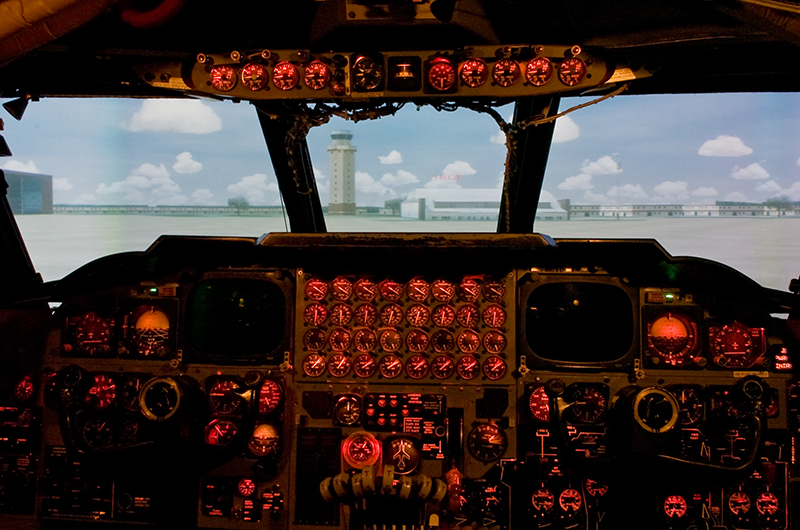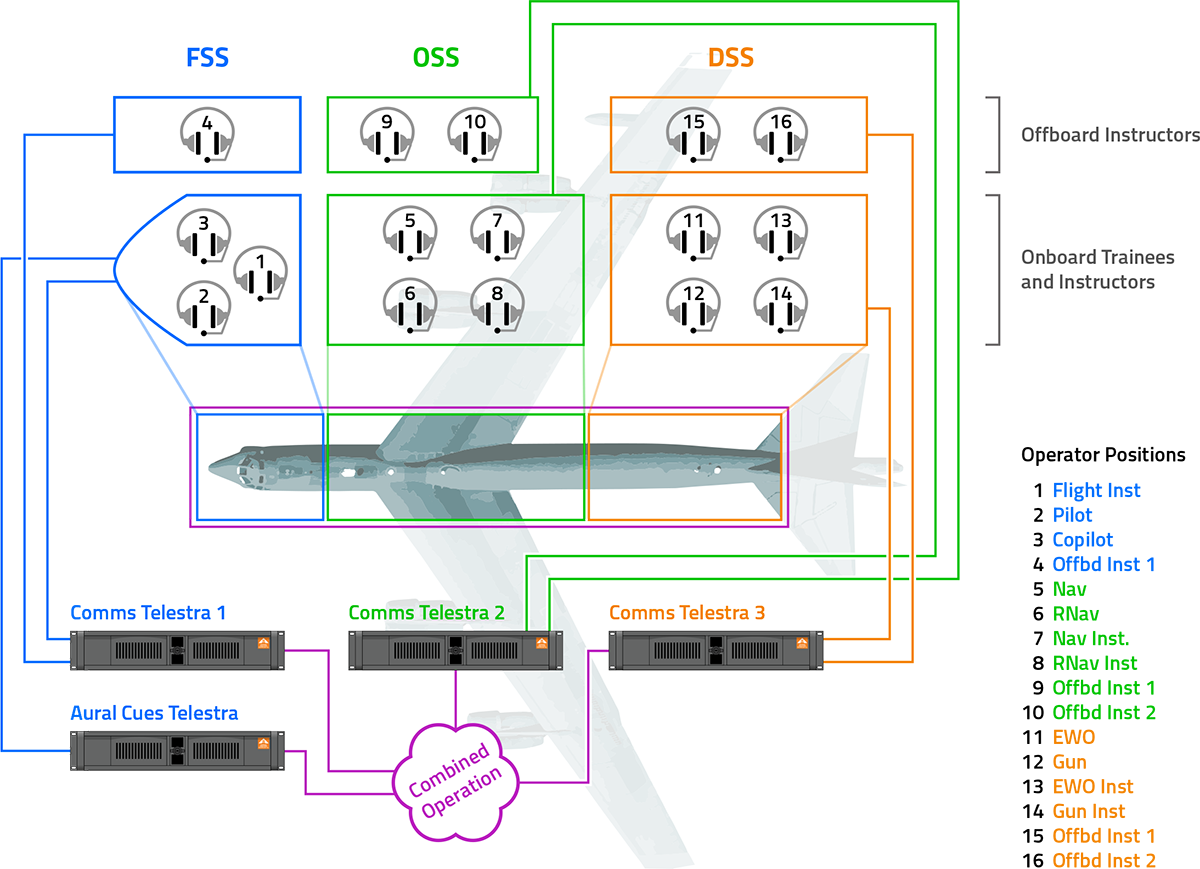Comms and Aural Cue System
B-52 Stratofortress Trainer
Customer
U.S. Air Force
Application
ASTi provided a comms and aural cueing solution for the U.S. Air Force’s long-range, strategic bomber flight simulator. The B-52 is a proven, cost effective airframe that will continue to be updated well into the middle of the 21st century, nearly 90 years after its initial entry into service. The complex, highly specialized crew positions require high fidelity training systems to maintain the U.S. Air Force’s strategic advantage on the world’s stage. ASTi continues to deliver an end-to-end communications simulation package that meets this platform’s specialized requirements.

In the cockpit of a B-52 simulator; U.S. Air Force photo by Lance Cheung
Challenges
&
Solutions
The challenge requirements are listed in blue; ASTi's applicable components are

In the cockpit of a B-52 simulator; U.S. Air Force photo by Lance Cheung
Support for Multiple Trainer Modes
Communications system that operates as three separate trainers or one unified trainer.
The B-52 simulator contains three trainers each with the ability to operate as an independent device. Or all three can work in concert as one large device representing a single B-52 airframe. The Flight Station Simulator (FSS), Offensive Station Simulator (OSS) and Defensive Station Simulator (DSS) provide realistic representations of the individual crew stations. For further realism, the entire “Combined Mode” trainer can operate on a distributed simulator network, connecting with other B-52 simulators, virtual operators, and other USAF assets.
To operate seamlessly in these various modes, the system architecture combines three Telestra communications servers, one for each independent sim. Whether in standalone or combined mode, each sim’s operators have access to all shared flightdeck and mission radios, navaids and radar countermeasure assets. Flight intercoms and malfunction states for the HF, UHF, VHF and SATCOM radios on board are all accurately modeled. The Telestra communications model uses shared, network intercoms to deliver real-time audio between the stations to achieve realistic distributed radios across all three. The combined mode allows the FSS, OSS and DSS to communicate as one unit just as in the actual aircraft.

High-Fidelity Radio and Intercom Switching (ICS) Modeling
Provide a high-fidelity, simulated radio environment with a range of realistic effects and an ICS system that fully replicates the aircraft intercom functionality.
ASTi's Telestra radio modeling environment provides the following radio simulation capabilities:
- Simulation of transmitters, receivers, navigational aids, and jammers
- Transmission/reception and station fade based on distance and signal strength
- AM/FM transmission and band interference
- Diffraction effects
- Specific radio type modeling such as SINCGARS, HF, UHF, VHF, satellite, and others
- Crypto and hopset system modeling
- Tones or noises heard for encrypted radios (preamble, postamble, mis-match)
- Antenna gain based on frequency
- Standard or user-defined background noise characteristics
- Lightning and background noise effects
- Communications jamming
- Voice messages for simulation of ATIS, GCA/CCA, ground stations background radio chatter
- Line-of-sight and over-the-horizon simulation
- Squelch, AGC, tuning tones
- World positioning of radios (geocentric, geodetic)
- Sidetone generation and control
- Press-to-talk, hot/cold mic, volume control
- Communication control panel simulation
- Proper half-duplex operation
- Separate transmit and receive frequencies within the same radio component
- Interface with a terrain, weather or effects server for enhanced propagation modeling
- Passing of data messages between radio objects
Simulated Communication Panels and ICS
The communications panel Telestra component provides modeling of ownship radio, receiver, and communications bus routing, switching, and mixing. Simulator communication panel switch states and volume settings are sent to the Telestra directly, with minimal logic manipulation by the host computer. Microphone audio, as well as transmit and receive signals, are mixed and routed to the appropriate headset based on the switch and volume state information.
The simulated Intercom Telestra component set provides sound modeling features and provides the capability to model complex communications structures such as: communications bus, communications control panel, audio signal routing and logic, and instructor/trainer inter-communications.
Simulated intercom capabilities include party line, point-to-point communications buses, and priority bus structures.
Some of the main features of Intercoms include:
- Flexible voice switching for intercom between trainees and instructors
- Point-to-point and party line/communication bus structures
- Networked intercom communications
- Voice warning and warning tone simulation
- Bus and warning tone priority capabilities
- Communication control panel simulation
- Selectable full- or half-duplex operation
- Sidetone generation and control
- Press-to-talk, vox, hot/cold mic, and volume control
- Priority bus assignment and control
Extensive Instructor and Role-Player Capabilities
Provide an expansive Instructor Operator Station (IOS) allowing instructors to role-play and provide feedback to students during an exercise.
ASTi developed a powerful IOS communications model supporting a wide range of capabilities:
- Instructors use a bank of communication assets, including VHF, SATCOM, and HF radios
- Support for multiple onboard instructors for each student position
- An offboard instructor area provides additional communication assets
Model Verification and Acceptance Testing
Test, verify and maintain the large, complex communications models through multiple release cycles.
ASTi has provided ongoing sustainment services to the B-52 program through multiple communication model updates and feature additions to maintain concurrency with the airframes in service. ASTi conducts rigorous internal acceptance testing between model updates and provides information assurance (IA) and software maintenance services. On-going help desk support is available to the B-52 team along with Telestra product training classes to simulator maintainers. These support services reduce risk and downtime for the in-service simulators.
Trainer Communication System (TCS) I/O
Provide an offline simulator communication system.
ASTi worked with the B-52 team to meet a requirement that mandated a secondary communications system that must function without relying on host inputs. This system would enable students and instructors to communicate throughout the normal training exercise, as well as in an emergency scenario where only the Telestra servers are powered and operational. To directly take instructor Rx/Tx selects from their TCS control panel, ASTi employed distributed digital I/O (DDI) hardware paired with its ACE-RIU device to collect microphone audio and provide audio output capabilities. This DDI-RIU combination allowed the ASTi system to act independently and provide essential communication functions when all other simulator subsystems were down.
The entire TCS subsystem is powered by an independent, uninterruptible power source that ensures operation during power outages.
Interoperability
Maintain ongoing compliance with USAF simulation standards including CAF DMO.
Telestra is field-proven interoperable across all of the DoD's training programs, including Air Force CAF DMO and MAF DMO, Army LVC-IA, Navy NIS, Marine Corps ADVTE, and Joint Staff JNTC. Recent ASTi updates to the B-52 JVoice channels supported further SISO and IEEE standards.
Aircraft Concurrency
Maintain concurrency of the simulator, staying up to date with updates provided to the real aircraft
The long life span of the B-52 aircraft means a long life for the simulator, as well. Updates and overhauls to the aircraft must also be reproduced in the simulator and the Telestra modeling system allows for that capability. For example, the recent addition of the Combat Network Communications Technology (CONECT) modification added critical communications capabilities to the B-52, including digital data links and other situational awareness equipment.
The Telestra is ready to model the changes with minimum engineering effort. New ARC-210 radio models, KY-100 crypto units, JVoice, and a new interphone system were added to the B-52 communications models on a small budget and short schedule.
Flexible software models allow the simulator to quickly switch between different versions of the aircraft. This gives operators the option to train on the version aircraft they need, with no downtime between changes.
ASTi conducts sustainment-related activities as part of our continual product lifecycle management process. Over the lifetime of a product, ASTi identifies and mitigates issues related to OS migration, hardware component availability, and obsolescence. ASTi customers inherit these commercial-off-the-shelf (COTS) product benefits, minimizing the impact of sustainment issues. This has allowed ASTi to service the B-52 sims for over 20 years.